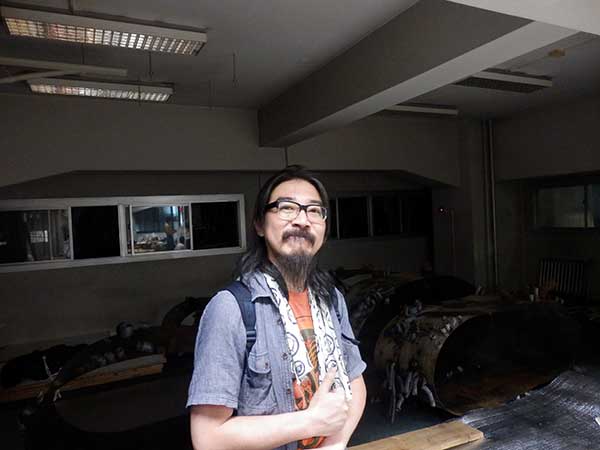Japan Noise on Film: Go Shibata 柴田 剛
Johannes Schonherr
In early autumn 1999, I went to Osaka to screen a program of vintage stag films, silent black & white porn made in the 1920’s in the U.S. and Mexico. At the time, only the most daring theaters in Japan would agree to screen a program like that. Osaka’s Planet Studyo +1 theater was one of them.

Run by film activist Kunihiko Tomioka and offering an auditorium of no more than 19 seats, the Planet Studyo +1 was hidden deep in a basement in the gay district of Doyama-cho in Umeda. Considering the size of the theater, I seem to recall that not many seats were empty during my short run of the stags.
The real surprise in Osaka however was Tomioka’s apartment. Located not far from the theater, it was a sort of campground for a young scene of filmmakers. People were crashing on the floor wherever they could in their sleeping bags, parties were going on day and night. And yet, the center of attention in the apartment was the 16mm Steenbeck editing table. Those young filmmakers camping out were all just waiting for their turn on that editing machine.
Kichiku
The young filmmakers were all students at the Osaka University of Arts (Osaka Gedai), it turned out.
The previous year, Osaka Gedai had refused to screen the graduation film of one of its most talented students, Kazuyoshi Kumakiri. Kichiku (鬼畜大宴会), Kumakiri’s film about a particularly bloody episode in the history of the Japanese radical left was considered too violent and too politically incorrect by the school officials.
Kumakiri’s film centers on a “seminar” of a leftist radical group taking place in the mountains of Gunma Prefecture in February 1972. Internal conflicts turned the “seminar” into a killer camp. For minor infractions, 15 group members were either executed outright or bound to trees outside – freezing to death in the mountain winter nights.
In Kumakiri’s film, nobody survives the ordeal. In reality, a group of survivors took over an inn in nearby Karuizawa, battling police for several days. Known as the Asama Sanso Incident, it was the final battle of the radical left in Japan. After that, the radical left lost almost all of its public support.
Because the school officials were absolutely set against Kumakiri’s movie, he went to look elsewhere for a premiere.
Tomioka agreed to show the film – which would then move onto the international film festival circuit. Visiting Tomioka’s apartment, Kumakiri spotted a precious device: the Steenbeck editing table . He told his fellow students about it and they made a run for Tomioka’s apartment. Those editing tables were rare and hard to access at school. At Tomioka’s house however, the Steenbeck was available in the midst of a party atmosphere.
When I arrived in Osaka in 1999, the scene centering on Tomioka’s apartment already celebrated their first big success: director Nobuhiro Yamashita had just departed for the Vancouver Film Festival with his slacker drama Hazy Days (どんてん生活), edited at Tomioka’s Steenbeck.
Shibata In Town
Go Shibata however was in town, in fact just working out the final touches on his graduation film NN891102. Shibata had been banned from Osaka Gedai for “causing too much troubles”. He had organized illegal concerts at the school and at one event, his band’s electrical equipment malfunctioned. A short circuit sent sparks, resulting in a major fire at the school. Shibata was persona non grata after that.
When I met him, he already lived in a sleeping bag on Tomioka’s floor for about 10 months. We immediately hit it off. Shibata and I would go to the Hatsubei, a tiny bar in the neighborhood serving takoyaki (pieces of fried octopus in a ball of dough) and cheap beer. Shibata didn’t speak any English at the time, I didn’t speak any Japanese. So, we just threw band names at each other. Einstürzende Neubauten? Agreed. Hanatarashi? Agreed. We went through the whole spectrum of Japanese underground and international punk / noise – and quickly became friends on musical grounds.
At my next visit to Osaka, Shibata, by then working out of his own little editing studio was able to show me his completed NN89102.
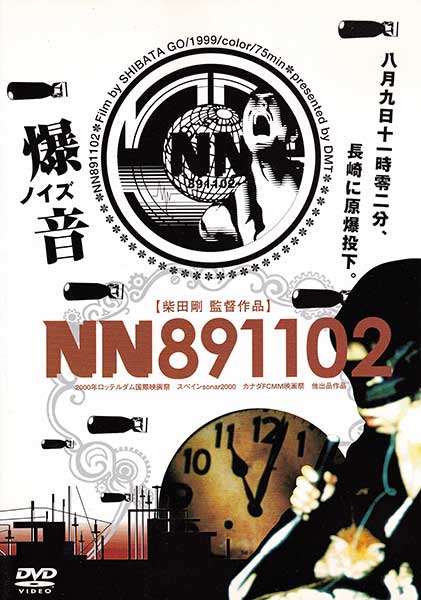
NN89102
NN89102 starts out with a 5-year old boy named Reiichi whose father works as a sound engineer in Nagasaki during World War II. Through his profession, Reiichi’s father was able to obtain a very early magnetic tape recorder. He kept it outside the city in a small cave close to his house and allowed his son to play with the machine.
In 1945, on August 9th at 11:02 am (hence the 891102 in the film title), the nuclear blast hit Nagasaki. Right at that time, Reiichi had pressed the “record” button of the tape machine. While his father died in the blast, Reiichi and the tape recorder survived the nuclear explosion unscarred. But did Reiichi record the sound of the blast?
The film doesn’t give a clear answer, The unfolding events in Reiichi’s life suggest however that he didn’t catch the sound of the bomb on tape. Reiichi spends the rest of his life trying to recreate the sound of the blast, often in dangerous experiments. Once he turns 60, in the year 2000, he is eventually successful, sort of, though it’s hard to interpret those dreamlike minutes concluding the film.
Make sure to play the video LOUD.
Given its focus on the creation of sound, NN891102 did not only tour international film festival like Rotterdam for instance but was also screened at experimental music events like the Sonar Festival in Barcelona.
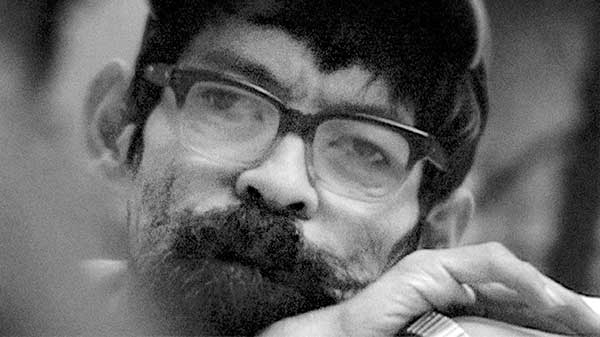
Late Bloomer (おそいひと) 2004
Already during the post-production of NN891102, Go Shibata met Toshihisa Fukunaga, a rather radical activist for the rights of the handicapped in Nishinomiya, a town located between Osaka and Kobe. Fukunaga suggested to Shibata to make a film dealing with the problems handicapped persons face and he also introduced him to a possible main actor – Masakiyo Sumida. Sumida had cerebral palsy, moved around in an electrical wheelchair, and communicated via a language computer in which he would type the words he wanted to say, the computer squeaking them out in an artificial voice. Sumida loved to drink beer, listening to noisy music and watching movies. Shibata was intrigued.
It took Shibata a few years to develop a workable story based on the daily life of Sumida and his true desires. His number one desire was of course to find a girlfriend and to experience sexual relations with a real women. Chances for that to happen were next to nil but it was this desire Shibata built his story on.
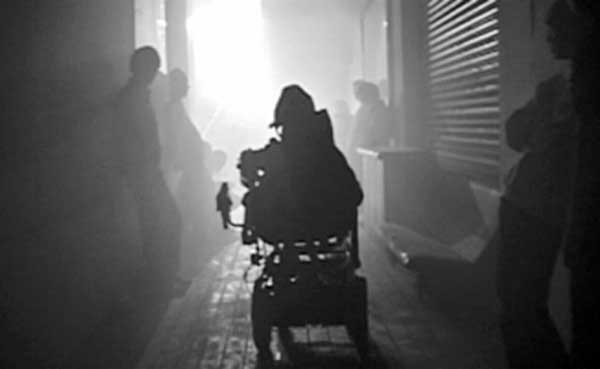
Late Bloomer premiered at Tokyo Filmex in November 2004. At the beginning, Sumida plays very much himself, his actual name is used in the film as the name of the character he portrays. Sumida often rides through Nishinomiya with his electric wheelchair, occasionally getting abruptly stopped by stairways he has no way to climb. Sumida has a cool caretaker, Take, played by Naozo Hotta. Shaven-headed Take plays in a punk band, he likes drinking lots of beers with Sumida and is generally the type of person Sumida wishes he himself could be. Successful with the ladies, knowing how to handle all those little things that make life enjoyable.
Problems start when Sumida’s old caretaker lady is replaced with a young girl named Nobuko (Mari Torii). Sumida mistakes her close attention as the beginning of that true love he had always desperately wished for. Instead, Nobuko falls for Take. Embittered Sumida murders Take – and gets away with it. Everyone thinks that Take drowned in a bathtub accident. From that moment on, there is no stopping Sumida to vent his pent-up rage. He randomly murders whoever he can, drunk salarymen being the easiest targets.
Shot digitally in b/w, viewers might expect in the first few minutes to see a social sob story – but then the plot develops into a bloody, violent serial killer nightmare.
International audiences were delighted. Late Bloomer played festivals all over the world. At festivals devoted to the outer fringes of the horror genre, like the FantAsia Festival in Montreal, Late Bloomer found a particularly receptive audience. The film received a theatrical release in the U.S., its New York premiere heralded by the New York Times.
Late Bloomer also proved to be the breakthrough for Tokyo electronic band World End’s Girlfriend whose dreamlike yet decidedly strange album Dream’s End Come True provided most of the soundtrack of the film. It’s incredible music. Listen to perhaps their best piece Singing Under the Rainbow, used as the soundtrack of a key scene in the film.
Punch the Blue Sky and Doman Seman
On the strength of Late Bloomer, Shibata was offered a job as a hired director for a movie about a young rock band seeking success in Takamatsu, Kagawa Prefecture. Punch the Blue Sky (青空ポンチ), premiered in 2008, was a light-hearted, entertaining film, very different from Shibata’s previous works.
Somewhat more related to Shibata’s own roots was his next film, Doman Seman (堀川中立売), 2009. Playing out in an alternate reality Kyoto dominated by the Kato the Catwalk Doman Seman Broadcasting Company, slackers face off against zombies. It’s never quite clear what’s “real” and what’s hallucination in the film and things turn quite chaotic at the end. Too chaotic for many viewers who walked out of the theater at the end of the movie unable to make any sense of it.
In the following years, Shibata turned to shooting music videos and to recording the research and strange happenings of artist collective Hyslom. Hyslom, according to their website,” usually conducts long-term anthropological field research on specific locations, people, and objects… with a focus on physically experiencing these changing environments with their bodies.
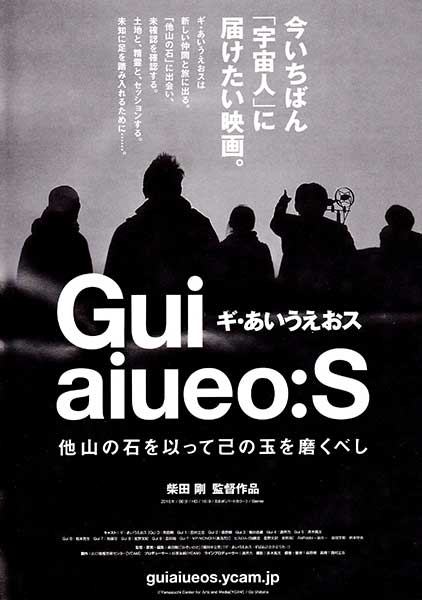
Gui aiueo: S (ギ・あいうえおス) 2016
With members of Hyslom, Shibata formed his own group, Gui aiueo: S. The name of the group roughly translates to The Aiueos, aiueo being the vowels in the Japanese hiragana alphabet. Thus, the group’s name means something like ‘the guys at the base’ or ‘the guys doing the ground work’.
With the group and a strange-looking van, all covered in tarp, Shibata went to the hilly grasslands in central Yamaguchi Prefecture, filming his documentary Gui aiueo: S.
The landscape is beautiful there but with the film shot on b/w digital video, you can’t make out much of the beauty. This is not a tourist film. You rather see Shibata and his friends recording sounds in the grasslands, listening to locals talking about ghost legends and planned ecological projects. UFO’s come frequently up in the conversations… and right at Himeji Central Park, a large amusement facility, the team captures on camera something that might pass as an Unidentified Flying Object. A flying object to be sure, but unidentified only to the guys with the camera. There might very well be a rational explanation of the flying object – but the film shows no efforts by the group to pursue any such explanation.
Rather, Yamaguchi is treated as a sort of magical wonderland, replete with a torch dance at Himeji Central Park and a mysterious dance performance set to droning guitar noise by Kyoto-based Antibodies Collective.
In short, Gui aiueo: S documents a search for meaning, a search for traditions and, most importantly, a search for a future.
An extensive interview by the author with Go Shibata on NN891102 was included in Matthew Edwards’ anthology
The Atomic Bomb in Japanese Cinema (McFarland 2015); an interview by the author with Go Shibata on Late Bloomer is included in Matthew Edwards’
Twisted Visions: Interviews with Cult Horror Filmmakers. (McFarland, 2017).
